高考英语复习 第8讲:连词和状语从句
- 格式:doc
- 大小:70.50 KB
- 文档页数:8
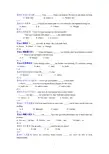
【2015黑龙江绥化】7._______ Tom _______ Nancy can help us. We have to ask others for help.A. Both; andB. Either; orC. Neither; nor7. C【2015河南】30. ______ we keep our hearts open, we can experience the happiness brings us.A. SinceB. IfC. UnlessD. Though30. B【2015海南】35. —How is Nancy getting on with her lessons?—She won’t catch up with others ________ she studies harder.A. afterB. unlessC. as soon as35. B【2015陕西】27. ____ you smile at others, they will smile back.A. BeforeB. WhenC. UntilD. Though27. B【2015福建厦门】24. ——What will happen ________ we hold the party next Monday evening?——Most of our classmates will not come.A. ifB. thoughC. since24. A【2015江苏淮安】7. I was writing a diary _____my brother was watching TV yesterday evening.A. beforeB. afterC. untilD. while7. D【2015湖南常德】22.I like PE _______ it’s funA. becauseB. soC. unless22. A【2015黑龙江龙东】15. —I won’t get good grades ______ I study hard.—That’s _______ everyone is trying his best to prepare for the exam.A. until; whyB. unless; whenC. unless; why15. C【2015黑龙江龙东】7. —Jim, how do your parents like country music?—______ my dad ______ my mom likes it. They both like country music.A . Eit her…or B. Not only…but also C. Neither…nor7. B【2015广西贵港】34. You’ll do much better in your exam ______ you’re more careful with your spelling.A. ifB. althoughC. unlessD. whether34. A。
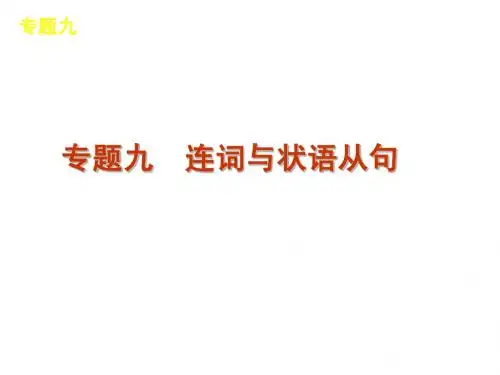
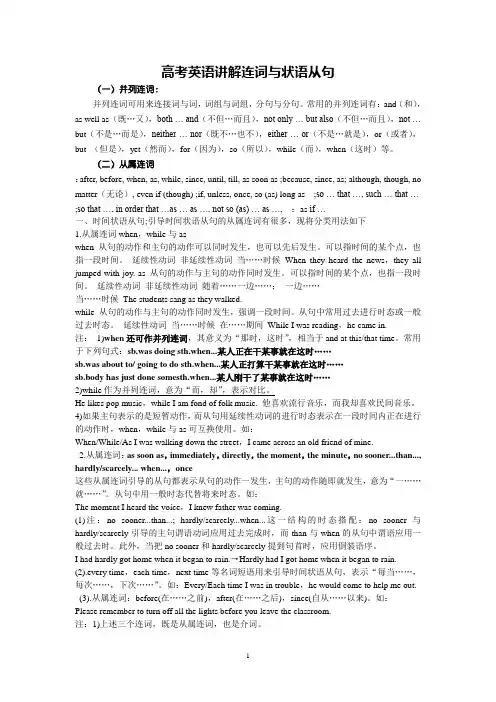
高考英语讲解连词与状语从句(一)并列连词:并列连词可用来连接词与词,词组与词组,分句与分句。
常用的并列连词有:and(和),as well as(既…又),both … and(不但…而且),not only … but also(不但…而且),not … but(不是…而是),neither … nor(既不…也不),either … or(不是…就是),or(或者),but (但是),yet(然而),for(因为),so(所以),while(而),when(这时)等。
(二)从属连词:after, before, when, as, while, since, until, till, as soon as ;because, since, as; although, though, no matter(无论), even if (though) ;if, unless, once, so (as) long as ;so … that …, such … that …;so that …, in order that …as … as…, not so (as) … as …, :as if …一、时间状语从句;引导时间状语从句的从属连词有很多,现将分类用法如下1.从属连词when,while与aswhen 从句的动作和主句的动作可以同时发生,也可以先后发生。
可以指时间的某个点,也指一段时间。
延续性动词非延续性动词当……时候When they heard the news,they all jumped with joy. as 从句的动作与主句的动作同时发生。
可以指时间的某个点,也指一段时间。
延续性动词非延续性动词随着……一边……;一边……当……时候The students sang as they walked.while 从句的动作与主句的动作同时发生,强调一段时间。
从句中常用过去进行时态或一般过去时态。
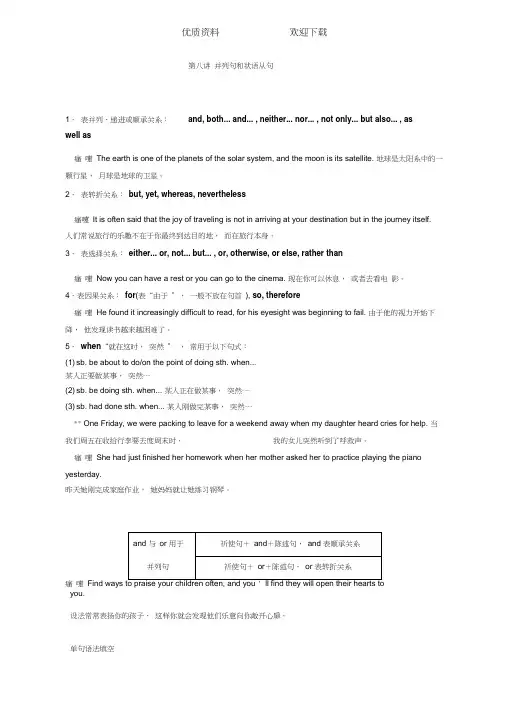
第八讲并列句和状语从句1.表并列、递进或顺承关系:and, both... and... , neither... nor... , not only... but also... , aswell as瘙嚔The earth is one of the planets of the solar system, and the moon is its satellite. 地球是太阳系中的一颗行星,月球是地球的卫星。
2.表转折关系:but, yet, whereas, nevertheless瘙嚔It is often said that the joy of traveling is not in arriving at your destination but in the journey itself.人们常说旅行的乐趣不在于你最终到达目的地,而在旅行本身。
3.表选择关系:either... or, not... but... , or, otherwise, or else, rather than瘙嚔Now you can have a rest or you can go to the cinema. 现在你可以休息,或者去看电影。
4.表因果关系:for(表“由于”,一般不放在句首), so, therefore瘙嚔He found it increasingly difficult to read, for his eyesight was beginning to fail. 由于他的视力开始下降,他发现读书越来越困难了。
5.when“就在这时,突然” ,常用于以下句式:(1) sb. be about to do/on the point of doing sth. when...某人正要做某事,突然⋯⋯(2) sb. be doing sth. when... 某人正在做某事,突然⋯⋯(3) sb. had done sth. when... 某人刚做完某事,突然⋯⋯瘙嚔One Friday, we were packing to leave for a weekend away when my daughter heard cries for help. 当我们周五在收拾行李要去度周末时,我的女儿突然听到了呼救声。
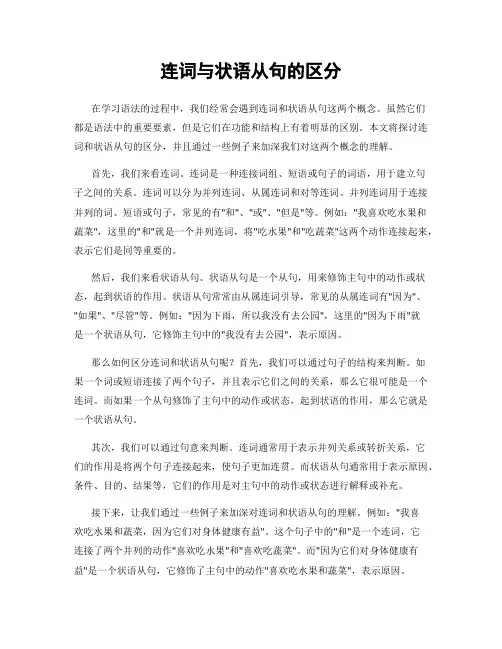
连词与状语从句的区分在学习语法的过程中,我们经常会遇到连词和状语从句这两个概念。
虽然它们都是语法中的重要要素,但是它们在功能和结构上有着明显的区别。
本文将探讨连词和状语从句的区分,并且通过一些例子来加深我们对这两个概念的理解。
首先,我们来看连词。
连词是一种连接词组、短语或句子的词语,用于建立句子之间的关系。
连词可以分为并列连词、从属连词和对等连词。
并列连词用于连接并列的词、短语或句子,常见的有"和"、"或"、"但是"等。
例如:"我喜欢吃水果和蔬菜",这里的"和"就是一个并列连词,将"吃水果"和"吃蔬菜"这两个动作连接起来,表示它们是同等重要的。
然后,我们来看状语从句。
状语从句是一个从句,用来修饰主句中的动作或状态,起到状语的作用。
状语从句常常由从属连词引导,常见的从属连词有"因为"、"如果"、"尽管"等。
例如:"因为下雨,所以我没有去公园",这里的"因为下雨"就是一个状语从句,它修饰主句中的"我没有去公园",表示原因。
那么如何区分连词和状语从句呢?首先,我们可以通过句子的结构来判断。
如果一个词或短语连接了两个句子,并且表示它们之间的关系,那么它很可能是一个连词。
而如果一个从句修饰了主句中的动作或状态,起到状语的作用,那么它就是一个状语从句。
其次,我们可以通过句意来判断。
连词通常用于表示并列关系或转折关系,它们的作用是将两个句子连接起来,使句子更加连贯。
而状语从句通常用于表示原因、条件、目的、结果等,它们的作用是对主句中的动作或状态进行解释或补充。
接下来,让我们通过一些例子来加深对连词和状语从句的理解。
例如:"我喜欢吃水果和蔬菜,因为它们对身体健康有益"。
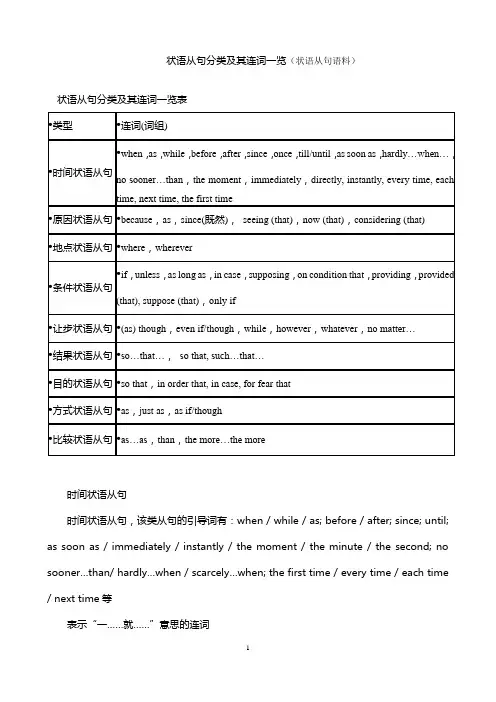
状语从句分类及其连词一览(状语从句语料)状语从句分类及其连词一览表时间状语从句时间状语从句,该类从句的引导词有:when / while / as; before / after; since; until; as soon as / immediately / instantly / the moment / the minute / the second; no sooner…than/ hardly…when / scarcely…when; the first time / every time / each time / next time等表示“一……就……”意思的连词The moment, the minute, the instant, immediately, instantly ,as soon as.时间状语从句语料If you don’t understand something, you may research, study, and talk to other people__until/till_____you figure it out.Over time, ____as/when___the population grew, people began cutting food into small pieces so it would cook more quickly.___ As/When _____the average age of population increases, there are more and more old people to care for.If be you miss this chance, it may years____before_____ you get another one.要过很多年你才能够得到再一次的机会。


第8讲并列句与状语从句1.Located________ the Belt meets the Road,Jiangsu will contribute more to the Belt and Road construction.(2021·江苏,23)A.why B.whenC.which D.where答案D解析句意为:由于位于“一带一路”的交汇处,江苏将为“一带一路”的建设做出更大的奉献。
空格处在过去分词located后面引导状语从句,且在从句中作地址状语,表示“在‘一带一路’的交汇处”,因此用where 引导状语从句。
2.—Peter,please send us postcards ________ we’ll know where you have visited.—No problem.(2021·北京,22)A.but B.orC.for D.so答案D解析句意为:——彼得,请寄给咱们明信片,如此(so)咱们就明白你去哪里旅行了。
——没问题。
后面表示结果,故用so。
but表转折;or表选择;for是表因果关系的连词,后接缘故。
3.________ birds use their feathers for flight,some of their feathers are for other purposes.(2021·北京,25) A.Once B.IfC.Although D.Because答案C解析句意为:虽然(although)鸟儿用羽毛来飞行,可是它们的一些羽毛也有其他用途。
前后为妥协关系,故用although引导状语从句。
once一旦,引导时刻状语从句;if假设是,引导条件状语从句;because因为,引导缘故状语从句。
4.If you don’t understand something,you may research,study,and talk to other people ________ you figure it out.(2021·北京,28)A.because B.thoughC.until D.since答案 C解析句意为:假设是不了解某个事物,你能够研究、学习、与他人探讨,直到(until)弄清楚。


高考状语从句一、状语从句的定义与作用状语从句在句子中起副词作用,用来修饰主句中的动词、形容词、副词或整个句子。
它可以表示时间、地点、原因、条件、让步、比较、方式、目的等不同的意义。
二、常见类型及用法1. 时间状语从句- 引导词:when(当……时候),while(在……期间,强调同时性),as (当……;随着),before(在……之前),after(在……之后),since(自从;既然),until/till(直到)等。
- 例如:- When I got home, my mother was cooking.(当我到家的时候,我妈妈正在做饭。
)- While I was reading, he was watching TV.(我读书的时候,他正在看电视。
这里强调读书和看电视这两个动作同时进行)- As we grow older, we become wiser.(随着我们长大,我们变得更聪明了。
)- Before you leave, turn off the lights.(在你离开之前,关灯。
)- After he had finished his homework, he went to bed.(他完成作业之后就去睡觉了。
注意这里从句动作先于主句动作完成,用过去完成时)- Since I came to this school, I have made many friends.(自从我来到这所学校,我交了很多朋友。
since引导的从句常用一般过去时,主句用现在完成时) - He didn't leave until/till his mother came back.(直到他妈妈回来他才离开。
)2. 地点状语从句- 引导词:where(在……地方),wherever(无论在哪里)。
- 例如:- Put the book where you can find it easily.(把书放在你容易找到的地方。
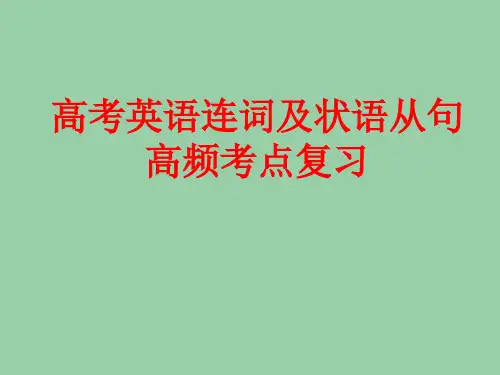
高考状语从句知识点状语从句是高考英语中的一个重要语法点,掌握好状语从句对于理解和运用英语句子结构、提高英语语言能力有着至关重要的作用。
接下来,让我们一起深入了解一下高考中常见的状语从句类型及其用法。
一、时间状语从句时间状语从句表示时间关系,常用的引导词有 when(当……时候)、while(在……期间)、as(当……时;一边……一边……)、before(在……之前)、after(在……之后)、since(自从……)、until / till(直到……)等。
1、 when 引导的时间状语从句When I was a child, I often played in the park(当我还是个孩子的时候,我经常在公园玩耍。
)When he arrived home, it was already midnight(当他到家时,已经是午夜了。
)需要注意的是,when 引导的从句动作可以与主句动作同时发生,也可以先于主句动作发生。
2、 while 引导的时间状语从句While I was doing my homework, my mother was cooking(当我在做作业时,妈妈在做饭。
)While he was reading, his sister was singing(他在读书时,他妹妹在唱歌。
)while 引导的从句动作通常是持续性的,且主句和从句动作同时发生。
3、 as 引导的时间状语从句As I was walking along the street, I met an old friend(当我沿着街道走时,遇到了一位老朋友。
)As time goes by, we become more mature(随着时间的流逝,我们变得更加成熟。
)4、 before 和 after 引导的时间状语从句I had finished my homework before my father came back(在我爸爸回来之前,我已经完成了作业。
高考一轮复习考点帮考点08-连词与语法填空原卷版考点08 并列连词和状语从句(原卷版)【命题趋势】连词是高考必考点,每年都保持在一至两个题目,命题形式除了语法填空外还在完形填空中进行考查,其考点主要句子之间的并列,转折,因果逻辑等。
要求考生熟悉句型结构,准确判断句子之间的逻辑关系。
状语从句则用来表示时间、地点、原因、条件、目的、结果等方面的关系。
语法填空题型中,该部分是必考内容。
状语从句的考查主要集中在条件状语从句、让步状语从句、时间状语从句、原因状语从句和结果状语从句等中。
解决状语从句的关键是找出句子之间或从句与主句之间的逻辑关系。
【重要考向】一、并列连词;二、状语从句的连词;并列连词【典例】【2022新高考I卷】After a three-year pilot period, the GPNP will be officially set up next year. TheGPNP is designed to reflect the guiding principle of “protecting the authenticity and integrity(完整性)of natural ecosystems, preserving biological diversity, protecting ecological buffer zones, __________ leaving behind precious natural assets(资产)for future generati ons”.【并列连词提分秘籍】1.主要连词用法归纳:分类连词意义例句注意表并列and和,又,而I make the payments and keep the accou- nts.我管付款和记账。
表并列not only...but also...不但……而且……①Not only is that problem very important,but(also) it is very difficult to be solved.那个问题不仅十分重要,而且还难以解决。
高考英语复习第8讲连词和状语从句[深化认知]一、并列连词1.并列连词的分类(1)并列关系:常用连接词and, as well as, both ... and, neither ... nor, not only ... but (also), not ... but等。
He had plenty of money and he spent it freely.他有很多钱,他花钱很随便。
Not only did he speak more correctly but (also) he spoke more easily.他不仅说得更正确了,而且说起来也更容易了。
Neither the students nor the teacher agrees to the plan.不仅是学生们而且老师也不同意这个计划。
A true man should be practical as well as far-sighted.一个真正的人不仅要有远见,而且还要讲究实际。
(2)转折关系:常用连接词but, however, still, while, yet, whereas等。
He likes pop music, while I am fond of folk music.他喜欢流行音乐,而我喜欢民间音乐。
(3)选择关系:常用连接词either ... or ..., or, or else, would rather ... than等。
Would you like to leave or would you like to stay?你愿意离开还是留下来?(4)因果关系:常用连接词for, so, thus等。
He must have been caught in the rain, for he is wet all over.他肯定被雨淋了,因为他浑身都湿了。
2.使用并列连词的注意事项(1)倒装:not only ... but (also) ...在连接并列分句时,如果not only置于句首,其所在的句子要用部分倒装。
Not only will help be given to people to find jobs, but (also) medical treatment will be provided for people who need it.(这个机构)不仅帮助人们找工作而且也为需要的人提供医疗护理。
(2)“祈使句+and/or+陈述句”,有时祈使句部分也可用名词短语。
Another try, and you will make a success.再试一次,你就会取得成功。
(3)下列句型中常用并列连词when:①be about to do sth. when ...“正要做某事,这时突然……”②be on the point of doing sth. when ...“正要做某事,这时突然……”③be doing sth. when ...“正在做某事,这时突然……”④had done sth. when ...“刚做了某事,这时突然……”He was walking in the street when he suddenly saw an old man fall off his bike.他正在街上散步,这时突然看到一位老人从自行车上摔了下来。
He was about to jump into the river when the guide stopped him.他正要向河里跳这时导游拦住了他。
二、状语从句(一)时间状语从句1.when, while, as(1)when既可引导一个持续动作,也可引导一个短暂动作,可用于主句和从句动作同时发生或从句动作先于主句动作。
When he knocked at the door, I was working at the table.他敲门时我正在桌子旁边工作。
(2)从属连词while引导的动作必须是持续性的,侧重主句动作和从句动作相对比。
Please don't talk so loud while others are working.在别人工作时,请别这么大声谈话。
(3)从属连词as可表示从句和主句的两个动作交替进行或同时完成,可译为“一边……(一边……)”或“随着……”。
As speech develops, the child starts to string more words together.随着语言能力不断发展,孩子开始把更多的词连起来说。
(4)如果主句表示的是短暂性动作,而从句用延续性动词的进行时态表示在一段时间内正在进行的动作,此时when, while与as可互换使用。
When/While/As I was walking down the street, I came across an old friend of mine.当我沿大街行走时,碰巧遇到了我的一个老朋友。
2.表示“刚……就……,一……就……”的常用表达(1)as soon as, immediately, directly, instantly, the moment, the minute, the instant, no sooner ... than ..., hardly/scarcely ... when ...和once。
上述从属连词引导的从句都表示从句的动作一发生,主句的动作随即就发生,常意为“一……就……”。
The moment I heard the voice,I knew Father was coming.我一听到那个声音就知道父亲来了。
My mom didn't wait a moment, but came immediately she received my call.我妈妈未等片刻,而是一接到我的电话就立刻来了。
(2)no sooner ... than ..., hardly/scarcely ... when ...的时态搭配:no sooner与hardly/scarcely 后的句子谓语动词应用过去完成时,而than与when引导的句子谓语动词应用一般过去时。
此外,当把no sooner和hardly/scarcely提到句首时,应用倒装语序。
He had no sooner finished his speech than the students started cheering.=No sooner had he finished his speech than the students started cheering.他刚完成演讲学生们就开始欢呼起来。
3.before与since(1)before表示“还未……就……;不到……就……;……才……;趁……;还没来得及……就……,在……之前”。
She left before I could say a word.我还没有来得及说话她就离开了。
(2)It will be+一段时间+before ...“多久之后才……”。
It will be three years before I graduate from college.三年后我才大学毕业。
(3)It won't be long before ...“不久之后就……”。
It will not be long before you regret for what you've done.不久你就会为你的所作所为后悔的。
(4)It was+一段时间+before ...“过了多久才……”。
It was several days before I realized that David had lied to me.几天之后我才意识到大卫对我撒谎了。
(5)It is+一段时间+since ...“自从……多久了”。
As is reported, it is 100 years since Tsinghua University was founded.像报道的那样,自从清华大学成立已经有100年了。
4.“每次……;下一次……”的常用表达every time, each time, next time, the last time, any time等名词短语用来引导时间状语从句,表示“每当……;每次……;下次……”等。
You don't have to go running upstairs every time she rings.用不着她一来电话你就往楼上跑。
Next time you go shopping, buy a few extra fruits and vegetables.下次你去买东西,多买点水果蔬菜。
5.till, until和not ...until(1)until或till表示“某动作一直延续到某时间点才停止”,此时主句谓语动词是延续性动词,主、从句都为肯定式。
这两个词可以换用,但till不可以置于句首,而until可以。
Have you heard the meeting will be put off till/until next Tuesday?你有没有听说会议将被推迟到下周二?(2)not ...until表示“某动作直到某时间才开始”,主句谓语动词是非延续性动词,从句为肯定式。
I won't tell the student the answer to the math problem until he has been working on it for more than an hour.直到这个学生做这道数学题用了一个多小时的时间,我才会告诉他答案。
(二)地点状语从句1.地点状语从句通常由连词where和wherever引导,从句可位于主句之前,也可位于主句之后。
A number of high buildings have arisen where there was nothing a year ago but ruins.很多高楼在以前只有废墟的地方拔地而起。
2.地点状语从句在句首时常兼有抽象条件意味。
Where there is a will, there is a way.有志者事竟成。
(三)条件状语从句引导条件状语从句的从属连词有:if, unless (=if ... not除非), so/as long as (只要), in case (万一), on condition that (条件是), suppose/supposing (that) (假设,如果), provided that (如果)等。